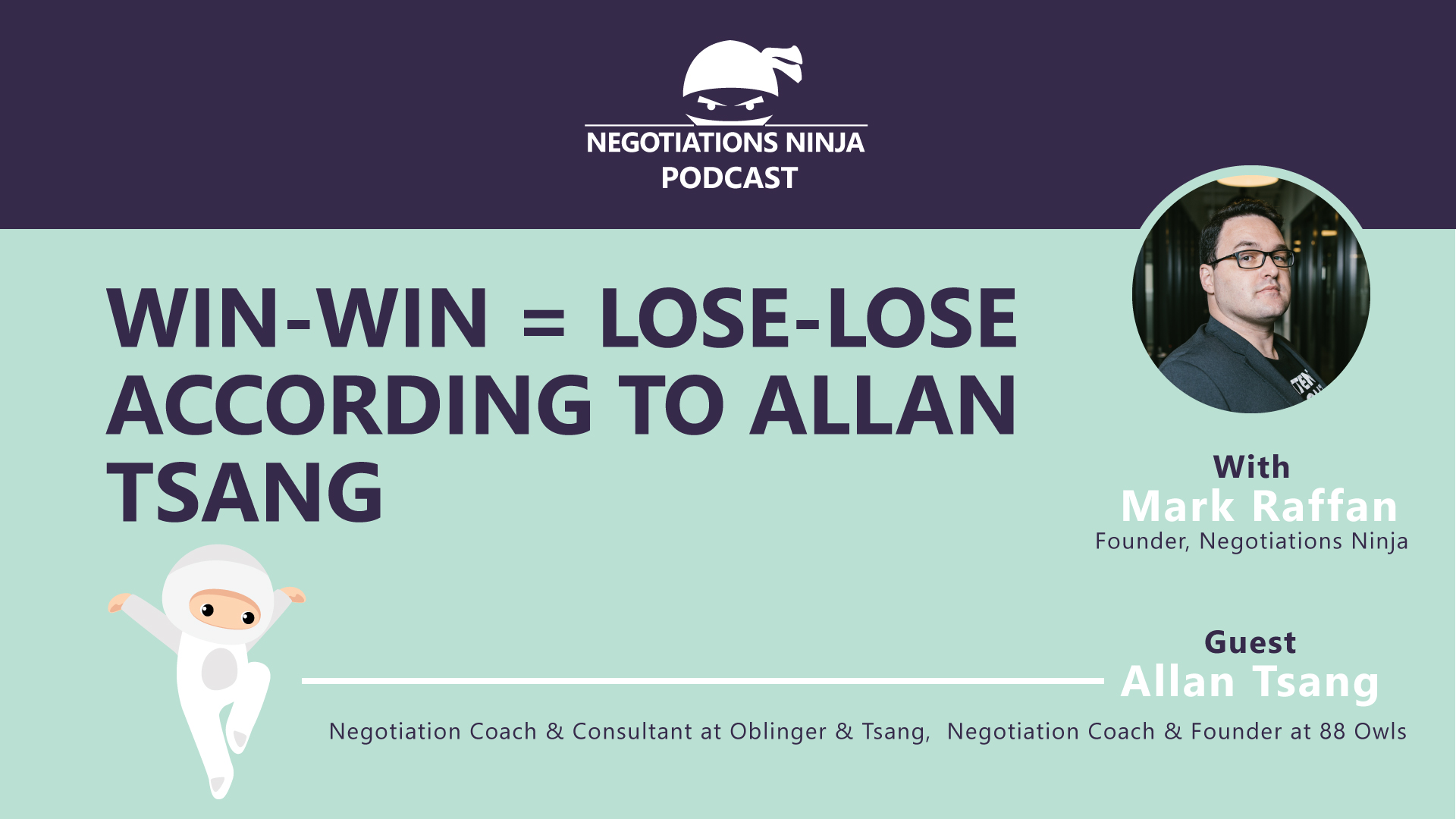Is win-win the best solution? Is any deal better than no deal? Is the ability to bluff a game-changer in a negotiation? Are these perpetuated truths fact—or fiction? In this episode of Negotiations Ninja, the myth-buster has returned. Allan Tsang joins me to shed some light on these long-believed negotiation myths (including the fallacy of win-win). Don’t miss this eye-opening conversation!
Outline of This Episode
- [2:00] All about Allan Tsang
- [3:33] Win-win is the best solution
- [10:49] Any deal is better than no deal
- [13:00] You have to be a smooth talker
- [14:58] The best deal = the best skills
- [18:26] You have to concede on price
- [25:23] Bluffing is important in negotiation
- [28:23] It’s good to compromise
- [32:16] Stop believing the overused truisms
- [37:36] Trust is necessary for success
- [46:42] Get a FREE White Paper from Allan
Myth: Win-win is the best solution
Allan easily states that win-win is a completely flawed paradigm. Why? Win-win implies that everybody wins. But the word “win” means that someone has to lose. It’s a nice idea, but it’s not realistic. When you’re a win-win person up against a win-at-all-cost person, the only thing you’ll end up with is unnecessary compromise.
When the other side uses pressure or aggression, win-win people fold. In the end, you want both parties to get what they want. It needs to be mission and purpose-focused. If your mission and purpose align, you can do business. You may reach a point where the mission and purpose no longer align, and you must part ways. You aren’t in competition.
But isn’t a win-win negotiation a focus on collaboration?
Should we shoot for a collaborative outcome? Allan says it can work—sometimes. The problem comes in when you’re up against an adversary out to take advantage of you. But he shares, “Developing a valid mission and purpose allows you to deal with nefarious players as well as those that play according to the rules.”
Win-win presupposes that you have to advocate for the needs and wants of the counterparty. But why would you want to help them win? Yes, you want them to come away with an outcome that makes sense. But why should you give away value? That doesn’t make sense. Allan believes that mentality comes from weak negotiators. Yes, he said it.
The Rule of Reciprocity
People who teach win-win say that it’s all about the rule of reciprocity. You give them something you don’t care about. They’ll feel obligated to give something back to you. People know what Allan thinks because he’s direct. He doesn’t play games. He teaches that you need to go in with a clear mission and purpose, find out their mission and purpose, and see how you can help them achieve what they want with terms that are acceptable to you.
There are parts of win-win that can work and should be practiced. It’s a good methodology to know because you will negotiate with these people. I agree with Allan that the mindset is too narrow. It’s too focused on one outcome versus driving value from multiple outcomes. If you go in with a win-win mindset, you’re going in under-pressure with a certain amount of neediness. You start to feel that something is better than nothing.
Win-Win = Lose-Lose
If both sides give up a little bit and both get away with a deal, people want to call it a win-win. But Allan points out that’s not true—it’s a lose-lose. It’s like saying let’s work on a lose-lose agreement where we both lose a little bit and walk away a little less happy.
I had a conversation with Chris Voss, and he said you have to be careful with experienced negotiators that talk about win-win. Those people are going to slit your throat and take everything you own, and you will be done. They are not in it for you—they’re in it for them. They’re using “win-win” as a persuasion tactic to lull you into a fall sense of security.
Stop believing the overused truisms
Some of the myths that we cover in this episode are overused truisms, and they don’t mean what you think they mean. The practical application of some of these is not fundamentally true. It sounds like splitting hairs—but it’s so important. Without proper definition around what something means—and digging into where it stems from—you tell a story that isn’t true. Then the foundation for everything you teach is faulty.
Resources & People Mentioned
- The Trust Factor: Negotiating in SMARTnership by Keld Jensen
- Life or Death Listening by Dan Oblinger
- Social Engineering by Chris Hadnagy
- Start with NO by Jim Camp
Connect with Allan Tsang
Connect With Mark
- Follow Negotiations Ninja on Twitter: @NegotiationPod
- Connect with Mark on LinkedIn
- Follow Negotiations Ninja on LinkedIn
- Connect on Instagram: @NegotiationPod




